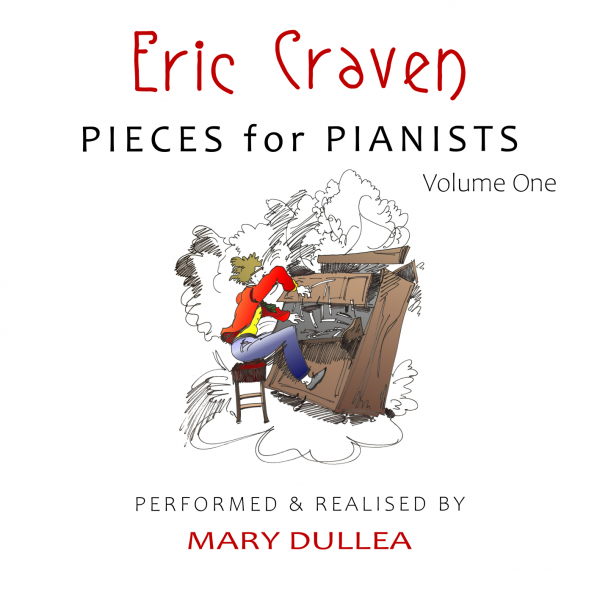Fanfare
This is the third release on the Métier label of piano music by the English composer Eric Craven to be reviewed in Fanfare. A recording of Craven’s Piano Sonatas Nos. 7-9 were reviewed by Peter Burwasser, Carson Cooman, and Maria Nockin in Issue 38:3 (Jan/Feb 2015). Peter J. Rabinowitz reviewed the composer’s Entangled States in 42:2 (Nov/Dec 2018). The pianist for both recordings is Mary Dullea. In each, she is credited as having both “performed and realised” the works at hand, for reasons I will explain.
Eric Craven has, over the past two decades or so, explored a form of musical expression he terms “Non-Prescriptive”. Craven’s “Non-Prescriptive” mode of composition embraces three levels. First is a “Lower Order”, in which “pitch, rhythm and duration of the notes are given. The performer decides upon such omitted parameters as tempo, dynamics, phrasing, pedaling and the articulation of the notes.” “Middle Order” components are “short fragments of data which can be presented in LO or HO systems of notation.” The final component, “Higher Order Non-Prescription is achieved by stripping away all parameters except pitch.”
(All quotes are from the composer’s website: ericcravencomposer.wordpress.com/introduction)
In short, Craven’s “Non-Prescriptive” technique affords performing artists a remarkably broad latitude in interpreting and realizing the music in the printed score.
Mary Dullea, Craven’s longtime advocate and collaborator, fully embraces the opportunities and challenges presented by Craven’s “Non-Prescriptive” method. In her commentary included in the liner notes for the new Métier release of Craven’s Pieces for Pianists, Volume One (2017-19), Mary Dullea praises the music as “open-ended, non-hierarchical, inclusive and, commensurate with his approaches to non-prescriptive notation.” Dullea encourages pianists who play this music to “Go and unlock your own musical past, and future.” Craven intends his Pieces for Piano (Two Volumes of 25 works, each), “to reward any pianist with even modest standards of ability with almost immediate success.” Although the technical difficulties increase as the works progress, “there is very little that will be beyond the capabilities of those who, because of life’s vagaries and vicissitudes, have perhaps not achieved the levels of pianistic excellence they once promised themselves.”
Again, it must be emphasized that what the Métier disc preserves are Mary Dullea’s “realizations” of Craven’s pieces. In the hands of another pianist (or perhaps, even in the hands of Dullea on another occasion), these works might sound notably different than what is preserved on the recording. In Dullea’s interpretations, Craven’s Pieces range in length from 1:20 to 4:49. Textures tend to be relatively spare, as might be expected for works intended for pianists of varying degrees of technical accomplishment. While Craven’s Pieces explore a wide range of moods and colors, they generally favor a more intimate and reflective mode of expression. To my ears, the Pieces evoke the piano music of such composers as Satie, Debussy, and Ravel, both in terms of textures and their harmonic world.
There are many other influences, of course. In his extensive and informative liner notes, Michael Quinn cites such composers as Cage, Pärt, and La Monte Young. But on the whole, if you enjoy the French Impressionists and their progeny, I think Craven’s Pieces for Pianists will be of particular interest to you. I fall into that category, and found this recording to be an engaging, captivating, and charming experience from start to finish. Dullea plays the music with clarity, sensitivity of phrasing, and an admirably rich palette of colors, all captured in first-rate sound. A fine recording, one that makes me look forward to hearing Volume Two.
@divineartrecordingsgroup
A First Inversion Company
Registered Office:
176-178 Pontefract Road, Cudworth, Barnsley S72 8BE
+44 1226 596703
Fort Worth, TX 76110
+1.682.233.4978




![Listen to the full suite of Marcel Dupré’s Variations Sur un Noël, Op. 20 from Alexander Ffinch’s #Expectations release today! listn.fm/expectations [in bio]](https://scontent-dfw5-1.cdninstagram.com/v/t51.71878-15/588904367_2327488161082898_8709236950834211856_n.jpg?stp=dst-jpg_e35_tt6&_nc_cat=105&ccb=7-5&_nc_sid=18de74&efg=eyJlZmdfdGFnIjoiQ0xJUFMuYmVzdF9pbWFnZV91cmxnZW4uQzMifQ%3D%3D&_nc_ohc=gQOLjaATqEIQ7kNvwE9Uzyw&_nc_oc=Adn3q63s98wEtuL_SWG9MBKzGBDVv67w3wCzHQqdNnZIRXxcbbjGshujw1BOgSmRShA&_nc_zt=23&_nc_ht=scontent-dfw5-1.cdninstagram.com&edm=ANo9K5cEAAAA&_nc_gid=ZGMcK32zvrhJV9o2eS7a9g&oh=00_AflOw_21xuMR0KmndOc99Ob25gtzHmtuCPZRD5ZTQrZ-Bg&oe=6944EE6A)

![“the ‘Manteca’ Paraphrase – a rare foray into the two-piano medium but here played double-tracked – exudes a panache of which Dizzy Gillespie would surely have approved.… [a] recital well worth investigating.” —Gramophone Magazine with high praise for Ophelia Gordon's debut release, Kapustin: Between the Lines!](https://scontent-dfw5-3.cdninstagram.com/v/t51.82787-15/598796470_18303255136283342_540941604740887837_n.jpg?stp=dst-jpg_e35_tt6&_nc_cat=108&ccb=7-5&_nc_sid=18de74&efg=eyJlZmdfdGFnIjoiRkVFRC5iZXN0X2ltYWdlX3VybGdlbi5DMyJ9&_nc_ohc=6FiEgYiNOZUQ7kNvwEvk531&_nc_oc=AdlqB8WskIE8mDxaJhgYT47d7tlOjvgS0lHljpi4DM0cEgIbO2mbaoTdA5Fk77Ku9Bo&_nc_zt=23&_nc_ht=scontent-dfw5-3.cdninstagram.com&edm=ANo9K5cEAAAA&_nc_gid=ZGMcK32zvrhJV9o2eS7a9g&oh=00_AfmcjvvYAFX9C4k7_F5u8ZPnsYGfWVB7tq-wvFQPhV6Wdg&oe=6944C8C4)





